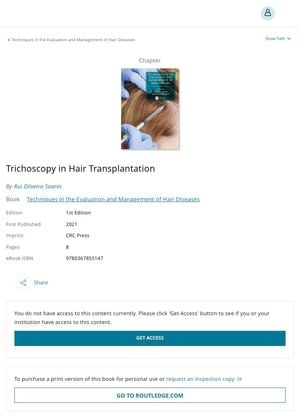Trichoscopy in Hair Transplantation
March 2021
in “
CRC Press eBooks
”
trichoscopy hair transplantation donor area hair phenotype micro-inflammation androgenetic alopecia hair loss miniaturization scarring inflammatory conditions lichen planopilaris LPP recipient areas empty slits hair transplant donor site hair type inflammation male pattern baldness baldness hair thinning scarring

TLDR Trichoscopy helps detect early complications in hair transplants and ensures quality in the procedure.
The document "Trichoscopy in Hair Transplantation" discusses the importance of trichoscopy in hair transplant procedures. It highlights that hair transplantation is a complex procedure with numerous variables, and that the dominance of the donor area in the hair phenotype was established 60 years ago. The paper also notes that micro-inflammation has been considered a significant factor in the physiopathology of androgenetic alopecia over the past two decades. It can contribute to both hair loss and miniaturization. The document emphasizes that undetected scarring inflammatory conditions, such as lichen planopilaris (LPP), can pose challenges for the transplant surgeon. Trichoscopy can aid in early detection of complications in both donor and recipient areas. The presence of a high percentage of empty slits, indicating missed recipient sites, is a sign of poor quality teamwork.




